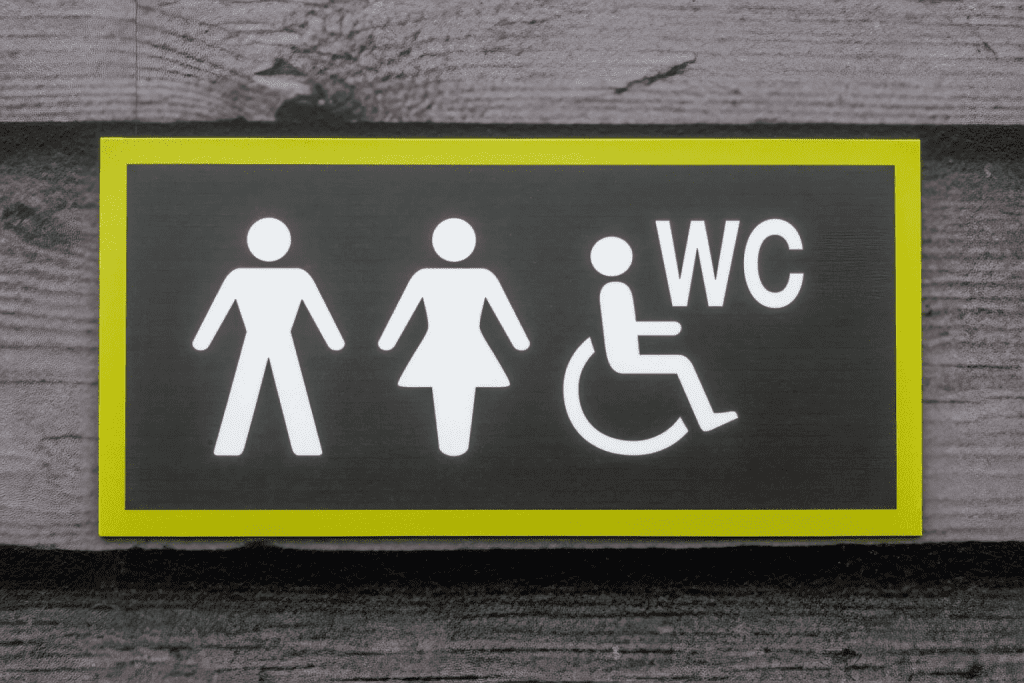Public toilets in the UK go by many names—restroom, loo, lavatory, and more. But one of the most common yet mysterious signs you’ll see is the ‘WC’. If you’ve ever wondered what it means, you’re not alone. The ‘WC’ sign is so ubiquitous in public restrooms, yet surprisingly, few people actually know what it stands for. Today, we’re diving into the history and meaning of this cryptic abbreviation that’s been around for centuries.

The Curious Case of the WC Sign: What Does It Mean?
The term ‘WC’ is an abbreviation that stands for “Water Closet.” Now, you might be wondering, why a closet? The origin of this term dates back to the late 19th century in England, a time when indoor plumbing was becoming more common in homes. Back then, many households had separate rooms for bathing and using the toilet. These were often referred to as bathrooms and closets, respectively. But here’s where it gets interesting.
As indoor plumbing became widespread, homeowners started converting small closets or cupboards into tiny rooms with a toilet inside. These rooms were some of the only places in the house with running water, which is where the term “Water Closet” came from. So, when you see a ‘WC’ sign today, it’s essentially pointing you to a room that, historically, was nothing more than a repurposed closet with a toilet.
Why Has the WC Sign Endured for So Long?
The persistence of the ‘WC’ sign is a fascinating example of how language and symbols evolve over time. While most people today refer to the room with a toilet as a “bathroom” or “restroom,” the WC abbreviation has stuck around, especially in older or more formal settings.
One reason for this is that the term “Water Closet” was once considered a more polite or refined way to refer to a toilet. In the Victorian era, when modesty and decorum were highly valued, euphemisms like “WC” were preferable to more direct terms. This preference for discretion has helped the term endure, even as indoor plumbing and modern bathrooms have become the norm.

The History Behind the WC: A Journey Through Time
To truly appreciate why the WC sign still exists, we need to take a closer look at the history of toilets and indoor plumbing. Before the advent of modern plumbing, people relied on outhouses or chamber pots, both of which were inconvenient and unsanitary by today’s standards. The introduction of indoor plumbing in the 19th century revolutionized how people lived.
Initially, indoor plumbing was a luxury reserved for the wealthy. These early plumbing systems typically included a bathtub in a designated “bathroom” but no toilet. The toilets were installed in small, spare rooms, often former closets, because they were one of the few places with the necessary plumbing infrastructure. Hence, the term “Water Closet” was born.
Over time, as plumbing technology improved and became more accessible, the Water Closet became a standard feature in homes. However, the name stuck, and today we still see it in use, particularly in public restrooms across the UK.

How the WC Sign Reflects Cultural and Linguistic Shifts
The WC sign is more than just a relic of the past; it also reflects broader cultural and linguistic shifts. Language is constantly evolving, and the way we talk about certain things—like toilets—can reveal a lot about societal attitudes.
In the case of the WC, its persistence demonstrates how euphemisms can become entrenched in everyday language. It also shows how certain terms, even when outdated, can retain their utility in specific contexts. For instance, while the average person might say “restroom” or “bathroom” in conversation, the WC sign remains widely understood and accepted, particularly in public or institutional settings.
Moreover, the use of ‘WC’ highlights the influence of British English on global language trends. Although the term is primarily used in the UK, it’s recognized and sometimes used in other parts of the world, including Europe and parts of Asia. This global recognition further cements the WC sign’s place in our shared cultural lexicon.

Why Knowing the Meaning of WC Matters
You might be thinking, “Why does it matter what WC stands for?” While it might seem trivial, understanding the meaning behind common signs and symbols can enhance your awareness of the world around you. It’s a small piece of knowledge that connects you to history, culture, and the evolution of language.
Moreover, being informed about such details can be surprisingly useful. Whether you’re traveling in a foreign country or simply navigating an unfamiliar public space, knowing what WC means can help you quickly find what you’re looking for—a place to relieve yourself! Plus, it’s a fun fact to share with friends or family, especially when someone inevitably asks, “What does WC stand for?”
The Evolution of Public Restroom Terminology
The term WC is just one example of how public restroom terminology has evolved over time. In addition to WC, there are numerous other terms used to describe public toilets, including “restroom,” “loo,” “lavatory,” and “bathroom.” Each of these terms has its own history and cultural connotations.
For instance, in the United States, “restroom” is the most common term used in public places, reflecting a more polite, understated approach to discussing bodily functions. In contrast, the British “loo” is a more colloquial term, often used in informal settings. Meanwhile, “lavatory” is a more formal, somewhat antiquated term that is still used in certain contexts, such as on airplanes or in high-end hotels.
Each of these terms serves a similar purpose, but their usage can vary significantly depending on the region, setting, and even the speaker’s social background. This diversity in terminology reflects the complexity of language and how it adapts to different cultural and social needs.
Conclusion: The Enduring Legacy of the WC Sign
In conclusion, the WC sign is more than just a label on a public restroom door. It’s a window into the past, offering insights into the history of indoor plumbing, the evolution of language, and cultural attitudes towards privacy and modesty. The next time you see a WC sign, take a moment to appreciate the rich history and cultural significance behind those two simple letters.
Whether you’re traveling abroad, exploring your local city, or simply enjoying a day out, knowing what WC stands for can enhance your understanding of the world around you. And who knows? You might even impress your friends with your newfound knowledge of toilet history!


